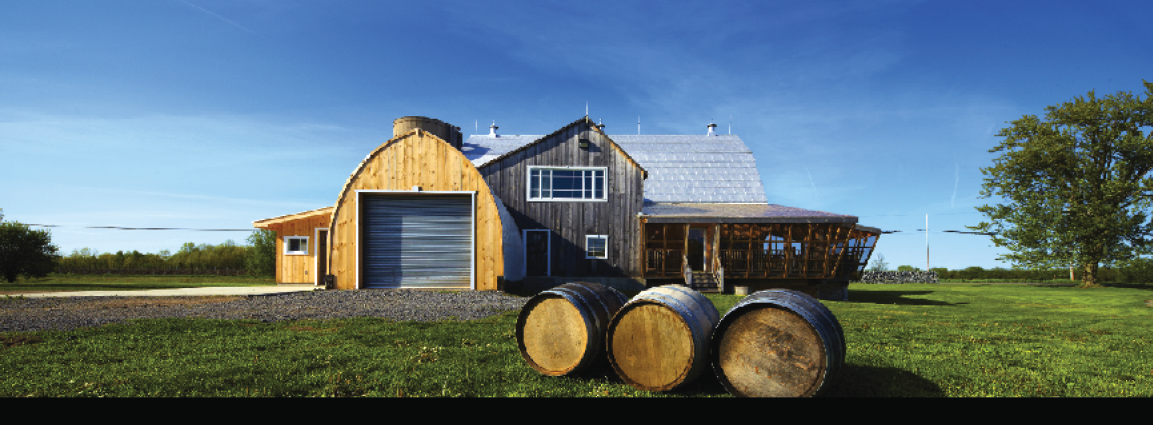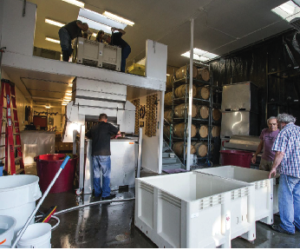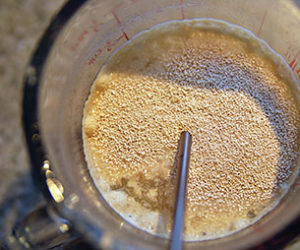
There is no better way to get to know a wine region than paying a visit and chatting up the winery management and their staff. It is then that you can learn more about the hard work and dedication that goes into making great wine. I recently visited Prince Edward County (PEC) in Ontario, Canada to learn more about the challenges of cool-climate enology and the stylistic techniques of an up-and-coming region that would also be applicable to the home winery and vineyard. I had the pleasure of interviewing three talented winemakers and vineyard managers: Ross Wise from Keint-he Winery and Vineyards, Ben Serpa from Harwood Estate Vineyards and Richard Karlo from Karlo Estates.
A Primer on “The County”
Referred to by the locals as the “The County” Prince Edward is the third (and most northern at 44 degrees latitude) appellation of origin and is located on the northeastern shore of Lake Ontario. The region was unveiled to the public in 2001 and much has developed over the past decade. The lake is the most influential geographical influence as it moderates the climate. The growing season tends to be prolonged as the grapes ripen in cooler temperatures that average in the low to mid 70s (20 to 25 °C). Geologically, the region is known for the Trenton limestone plateau.
Ross explains, “The calcareous, limestone-rich, clay loams we have provide the vines with plenty of minerals to grow in and draw from, and this shows through in the wine. The limestone base is also an impediment to root growth, which controls vigor by limiting water uptake.” What yields are obtained in a typical County vineyard? Ben also mentions, “A grapevine that in some areas may yield 3–4 metric tonnes per acre may only yield 1–2 metric tonnes per acre in PEC.” The result of slow development and low yields is retention of acidity and intensification of flavors and aromas, which are hallmarks of County wines. The principle grapes of the region are those that thrive in the limestone rich soil and tolerate a cool climate. Chardonnay and Pinot Noir are the key Vitis vinifera varietals, while mixed-heritage vines including Baco Noir, Traminette, Marquette and Frontenac Gris make regular appearances.
Tough Challenges All Year
The most daunting task of all year (other than tasting, I suppose) in this cold climate is the labor of ‘hilling up’ the vineyard before the extreme winter chill strikes. Temperatures easily reach into the -22 °F (-30 °C) territory, which would kill vinifera varietals. Before the soil hardens from frost, individual canes that will produce next year’s growth are taken off their fruiting wires and then tied low to the ground. In between each row, a V-plow is used to push soil outwards, burying the vines with 12 to 18 inches (30 to 45 cm) of soil. It can take as much as three passes to build up enough soil.
“Having to bury vines in the winter to keep them alive is pretty extreme. It doesn’t get much tougher than that in viticulture,” said Ross Wise of Keint-he Winery and Vineyards.
De-hilling is the reverse process, but equally tedious. The buried canes are prone to snapping as the dirt is piled on or taken off; therefore they recommend burying one or two extra canes per plant for insurance purposes. Ben Serpa brought up another good point to consider when pre-planning how one may want to train the vines: “(Our) grapevines are very low to the ground. This allows us to be able to tie down canes without extreme bends. The more the cane arches the higher chance you have to break it when we pile dirt to cover it for the winter.” The timing of when to un-hill is an onerous decision. “If we bring the canes out too early, we risk getting hit with spring frost,” Ben explains, “If we leave them in the ground too long we risk the canes budding underground.”
Alternatively, the hybrid vines are quite winter hardy and can withstand the deep chill without having to be hilled upon. All winemaking enthusiasts can recall a particularly troublesome year that really “got under their skins” (pun intended). The vintage of 2008 was most troublesome here, known for its fierce winter, cooler growing season and relatively wet harvest time. Richard Karlo recalls the challenge of dealing with a harvest of red grapes that would have resulted in relatively lighter wines that lacked color. In such situations, he recommends prolonging the hang time enough to avoid rot, and to increase the length of skin contact (sometimes drawn out for weeks) under refrigerated conditions to stall fermentation. Elsewhere, Ross Wise indicated that the team at Keint-he might have thrown in the towel. Amidst a moist autumn, which is not uncommon for the area, they were on the verge of losing the entire crop (mainly Pinot Noir) to Botrytis. “Instead of writing it off, we got creative and made a Botrytis-affected Pinot Noir [bottled as 2008 Pinot Sauvage]” said Ross. “It took several passes through the vineyard, picking individual bunches of berries as they dried out . . . we hope not to have to make it again but that is what nature gave us.”
Experimental Ideas for Winemaking
There exists the obvious challenge of getting noticed amongst your peers when you have popular appellations neighboring the county, such as Niagara Peninsula and Lake-Erie North Shore. Just as it is the passion of the home winemaker to show that they do things in their own unique way, I also realized that the Prince Edward County wineries had uniqueness in their wines that expressed both artistic and scientific influences.
For one, Keint-he’s Pinot 2 (‘Pinot-squared’) is a blend of both Pinot Noir and Pinot Meunier and is one of their “off the beaten path” wines. The blend is commonly seen in the Blanc-de-Noirs of Champagne but the winery has a knack for creating table wines from the blend. “We have both of these varieties planted in our vineyards,” Ross explains, “and in one hot vintage we decided to make a small amount of Pinot Meunier as a (single varietal) red wine. It developed a great following so we continued to make it.” Pinot Noir is an especially finicky grape, but as Ross advises, “It is always about keeping it as simple as possible, especially with Pinot Noir. The more you try and impose on the grapes or flavor of the wine, the more you lose the true essence of the wine and its terroir.”
Richard Karlo has learned to play into the naturally high acidity for the structure it imparts into the wine but so as to not dominate the flavor profile. He does this by allowing for some residual sugar as a balance and that way the fruit characters can more easily be sensed on the palate. When working with Riesling, Richard aims for an off-dry profile and ferments in barrels. It sounds really bizarre but he uses 6-year-old barrels that used to be the home of some Chardonnays. “The tartaric acid tends to stick to the inside of the barrel, so it’s a way of de-acidifying the wine without adding anything chemical.” The barrel experimentation doesn’t end there. Karlo Estates ages a portion of their Chardonnays in “CHOA” barrels. The Cherry-Hickory-Oak-Ash hybrid barrels, made by alternating staves, were made for aging balsamic vinegar. After three months of aging in these barrels, the spice and vanilla notes are well integrated without being at the forefront of the flavor profile.
A Walk on the Wild Side
With some of the winemaking methodology at the wineries I visited, I was surprised at the hands-off approach. I was even taken aback to remarks that they perform fermentations from wild strains (and some of them exclusively use wild flora). From my microbiologist background, making great wine on our side of the world using wild ferments can yield fabulous results. The home winemaker can also experiment the same way. The first step for this is knowing the reputation of the vineyards from where the grapes are sourced. Often at a winery, when the grape must proceeds through the initial fermentation stages without complications, the skins are typically dispersed among the field as compost. In effect, we perpetuate a sort of selective pressure on the yeast, where the fittest organisms survive and are allowed to re-propagate amongst the vines for next year’s vintage. The second and equally important aspect is knowing enough about the dynamics of what is occurring in the fermenting must. How quickly are the sugars being consumed? Are the concentrations of nutrients, such as nitrogen, sufficient? With the availability of chemical testing kits and enological testing services from wineries it is now easier to monitor the fermentation and produce wine with the greatest sense of place and complexity.
The County Sweet Tooth
Canada first made a splash on the international wine map with the Icewine of Niagara and satisfied a large market of sweet-toothed consumers. It is typically difficult for a small winery, (let alone a home winemaker), to grow their very own ice wine grapes. Yet some County vintners still manage to satisfy the tip of our tongues. “Ripening and sugar? It’s not uncommon to harvest Marquette at 29+ degrees Brix,” Ben explains, “The mixed-heritage grapes are a little more acidic generally, lending themselves to a sweet wine easily.” Marquette is a hybrid grape of complex genetics. Developed at the University of Minnesota, this red grape has some Frontenac and Pinot Noir in its parentage. It was developed to be resistant to mildew and the fierce northern winters. At Harwood Estates, the grape is used to make a red Port-style wine. Surprisingly, Karlo Estates’ flagship and best seller is a white Port-style made from a blend of estate grown Frontenac Blanc and Gewürztaminer. Richard comments, “I like to make the wine a little less fortified and a little less sweet than traditional Ports to bring out the natural acidity so it finishes cleaner on the palate.”
Turning Challenge into Possibility
“Dealing with the huge differences that each growing season brings us is a challenge, but it is also part of the fun. We get to bottle not only a sense of place, but also a sense of time.” Ross explains, about County winemaking and viticulture. My trip was both educational and inspirational as many of the challenges and tips these three winemakers described could be translated to the enthusiast winemaker or those looking to go pro in a cool climate. It is the challenge of growing grapes and winemaking that makes us learn and we are encouraged to strive for our best creations — and, of course, hard work simply tastes better.






